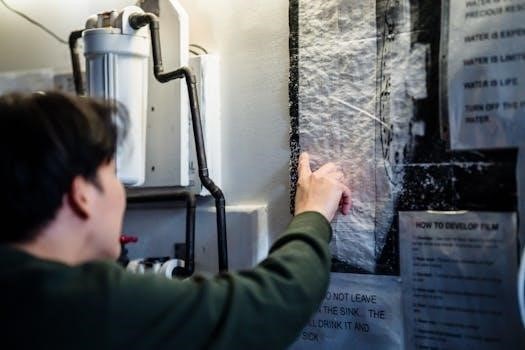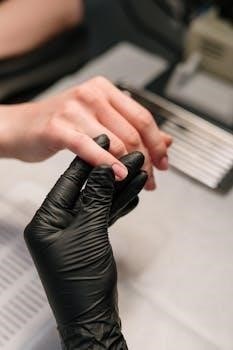The Lapiplasty technique guide offers a comprehensive look at a revolutionary approach to bunion correction. This guide outlines the key steps, principles, and considerations involved in performing the Lapiplasty procedure, a modern solution for addressing bunion deformities in three dimensions to restore natural alignment.
Overview of Lapiplasty Procedure
The Lapiplasty procedure represents a significant advancement in bunion correction, offering a three-dimensional (3D) approach to address the root cause of the deformity. Unlike traditional bunion surgeries that often shave off the bony prominence, Lapiplasty corrects the unstable joint at the base of the big toe, known as the metatarsocuneiform joint. This innovative technique involves realigning the bones in all three planes – transverse, horizontal, and frontal – to restore the natural anatomy of the foot.
The procedure utilizes patented instrumentation and fixation technology to achieve precise correction and stable fixation. By addressing the instability at the joint, Lapiplasty aims to provide a more durable and long-lasting correction compared to traditional methods. The goal is to not only remove the bunion but also to prevent its recurrence by correcting the underlying biomechanical issue.
Lapiplasty typically allows for quicker weight-bearing compared to conventional bunion surgeries, potentially leading to a faster recovery and return to normal activities. The procedure’s precision and stability contribute to improved patient outcomes and satisfaction. This technique helps people suffering from bunions to regain mobility and reduce pain.
Indications for Lapiplasty
Lapiplasty is indicated for individuals suffering from moderate to severe bunion deformities, also known as hallux valgus. This innovative procedure is particularly suitable for patients whose bunions are caused by instability at the metatarsocuneiform (TMT) joint, the joint at the base of the big toe. Patients who have experienced previous bunion surgery failures may also be candidates for Lapiplasty, as the procedure addresses the root cause of the deformity.
Individuals experiencing significant pain, difficulty wearing shoes, and limitations in daily activities due to their bunions may benefit from Lapiplasty. The procedure is designed to correct the bunion in all three dimensions, providing a more comprehensive and lasting solution compared to traditional bunionectomies.
Lapiplasty can also be considered for patients with certain anatomical characteristics, such as a high metatarsal-cuneiform angle or excessive pronation of the foot, which contribute to bunion development. Furthermore, those seeking a faster recovery and earlier return to weight-bearing activities may find Lapiplasty an appealing option. A thorough evaluation by a qualified foot and ankle surgeon is essential to determine if Lapiplasty is the most appropriate treatment option for each individual’s specific condition and needs. The procedure offers hope for lasting bunion relief.
Patient Selection Criteria
Careful patient selection is paramount for successful Lapiplasty outcomes. Ideal candidates typically exhibit a combination of clinical symptoms, radiographic findings, and realistic expectations. A thorough assessment includes evaluating the severity of the bunion deformity, the degree of instability at the TMT joint, and the patient’s overall foot and ankle alignment.
Radiographic evaluation plays a crucial role, with weight-bearing X-rays used to measure angles such as the hallux valgus angle, intermetatarsal angle, and TMT joint alignment. Patients with significant TMT joint instability, as demonstrated by radiographic stress testing, are often excellent candidates.
Beyond the physical aspects, patient motivation and adherence to post-operative protocols are essential. Individuals who understand the importance of following weight-bearing restrictions, wearing prescribed footwear, and participating in rehabilitation exercises are more likely to achieve optimal results. Exclusion criteria may include patients with severe peripheral vascular disease, active infections, or significant medical comorbidities that could compromise healing. Ultimately, the decision to proceed with Lapiplasty should be made collaboratively between the surgeon and patient, ensuring a clear understanding of the potential benefits and risks.
Pre-operative Assessment and Planning

Comprehensive pre-operative assessment and meticulous planning are critical for successful Lapiplasty outcomes. This phase involves a detailed evaluation of the patient’s medical history, physical examination, and radiographic studies to determine the extent of the deformity and any associated pathologies. Weight-bearing X-rays are essential for assessing the hallux valgus angle, intermetatarsal angle, and the alignment of the tarsometatarsal (TMT) joint.
The surgeon must carefully analyze the radiographs to identify the apex of the deformity and assess the degree of instability at the TMT joint. Advanced imaging techniques, such as CT scans or MRI, may be considered in complex cases to evaluate bone morphology and soft tissue structures. A thorough vascular and neurological examination is also crucial to identify any potential contraindications or risk factors.

Pre-operative planning involves selecting the appropriate implant size and determining the optimal correction strategy based on the individual patient’s anatomy and deformity. The surgeon should also discuss the surgical procedure, potential risks and complications, and post-operative expectations with the patient to ensure informed consent and realistic expectations.
Surgical Technique⁚ Key Steps
The Lapiplasty procedure involves a series of precise surgical steps aimed at correcting the bunion deformity in all three planes. The initial step involves a direct dorsal incision over the tarsometatarsal (TMT) joint. A full-thickness, subperiosteal tissue envelope is then created from the proximal pole of the cuneiform to the midshaft of the first metatarsal to allow for adequate exposure and mobilization of the joint.
The TMT joint is carefully prepared by removing any osteophytes or hypertrophic tissue. Specialized instrumentation is used to achieve precise triplanar correction of the deformity. Provisional fixation is then achieved using K-wires or bone tacks to maintain the corrected alignment. Fluoroscopic guidance is essential throughout the procedure to ensure accurate joint reduction and proper implant placement.
Once satisfactory alignment is confirmed, definitive fixation is achieved using anatomically shaped titanium plates and screws. The plates are designed to provide stable fixation and promote fusion of the TMT joint in the corrected position. The wound is then closed in layers, and a sterile dressing is applied. Post-operative protocols are crucial for optimal healing and rehabilitation.
Incision and Exposure

The initial phase of the Lapiplasty procedure involves meticulous incision and exposure to access the underlying tarsometatarsal (TMT) joint. A direct dorsal incision is strategically placed over the TMT joint, carefully considering the anatomical landmarks and neurovascular structures. The length of the incision is tailored to the patient’s anatomy and the extent of the deformity. Sharp dissection is carried out through the skin and subcutaneous tissues, taking care to protect the cutaneous nerves and vessels.
Once the deep fascia is reached, it is incised in line with the skin incision. Full-thickness flaps are then elevated to expose the TMT joint capsule. A key step is the creation of a complete subperiosteal tissue envelope, extending from the proximal aspect of the medial cuneiform to the midshaft of the first metatarsal. This extensive exposure is essential to adequately visualize the joint surfaces and facilitate the subsequent deformity correction and joint preparation.
Careful attention is paid to releasing any soft tissue restrictions around the TMT joint that may contribute to the bunion deformity. The extensor hallucis longus (EHL) tendon and its sheath are identified and protected throughout the procedure. Adequate exposure is paramount for accurate joint resection and stable fixation.
Joint Preparation and Deformity Correction
Following adequate exposure, the next crucial step in the Lapiplasty procedure is meticulous joint preparation and deformity correction. This involves carefully resecting the cartilage from the TMT joint surfaces to promote fusion. Specialized instruments are used to ensure precise and complete cartilage removal, optimizing bone-to-bone contact.
With the cartilage removed, the bunion deformity is addressed in three dimensions. The Lapiplasty system allows for correction of the transverse, sagittal, and frontal plane deformities. Using specific instrumentation, the metatarsal bone is realigned to its anatomical position, correcting the bunion at its root cause. Temporary fixation pins may be used to hold the corrected position while assessing the alignment under fluoroscopy.
A trial reduction is performed to visualize the final correction and ensure proper joint congruity. Adjustments are made as needed to achieve optimal alignment and stability. The goal is to restore the natural biomechanics of the foot, reducing pain and preventing recurrence of the bunion deformity. Once satisfactory correction is achieved, definitive fixation is implemented to maintain the corrected position.
Fixation Techniques and Implants
After achieving the desired joint preparation and deformity correction, secure fixation is paramount in the Lapiplasty procedure. This ensures long-term stability and promotes successful fusion of the tarsometatarsal (TMT) joint. The Lapiplasty system utilizes specialized, low-profile titanium plates designed for optimal fixation across the TMT joint.
These anatomically shaped plates are strategically positioned to provide multiplanar stability, resisting forces in all directions. Typically, two plates are used, one on the dorsal aspect and another on the plantar-medial aspect of the joint. The plates are secured with screws that are carefully placed to maximize purchase in the surrounding bone.
Compression across the joint surfaces is crucial for promoting fusion. Some Lapiplasty systems incorporate compression screws or mechanisms within the plates to achieve this. Fluoroscopic guidance is utilized to ensure accurate plate and screw placement, avoiding critical structures and optimizing fixation strength.
The implants are designed to be permanent and generally do not require removal. The low-profile design minimizes the risk of soft tissue irritation. The choice of implant size and configuration depends on individual patient anatomy and surgeon preference.
Fluoroscopic Guidance and Checks
Fluoroscopic guidance plays a pivotal role throughout the Lapiplasty procedure, ensuring accuracy and precision in every step. Real-time imaging allows the surgeon to visualize the bones and joints, facilitating accurate reduction of the deformity and proper placement of implants. Before making any cuts or corrections, fluoroscopy confirms the initial alignment and identifies the precise location for the osteotomies.
During joint preparation and deformity correction, fluoroscopy guides the surgeon in achieving the desired three-dimensional realignment. It verifies the correction of the hallux valgus angle, intermetatarsal angle, and any rotational component of the deformity. After applying fixation, fluoroscopy is essential to confirm the correct positioning of the plates and screws.
It ensures that the screws are engaging the bone adequately and are not impinging on any adjacent structures. Fluoroscopic views in multiple planes assess the overall alignment of the foot and ankle, verifying that the correction has been achieved as planned. Stress views can also be obtained under fluoroscopy to assess the stability of the fixation and the integrity of the joint.
Any necessary adjustments can be made immediately under fluoroscopic guidance, optimizing the final outcome. This real-time feedback minimizes the risk of malalignment or fixation failure, contributing to the long-term success of the Lapiplasty procedure.

Post-operative Protocol and Rehabilitation
The post-operative protocol following Lapiplasty is crucial for ensuring optimal healing and a successful return to function. Initially, the focus is on protecting the surgical site and managing pain. Patients typically wear a surgical boot or cast to immobilize the foot and ankle. Elevation and ice are essential to minimize swelling and discomfort during the first few weeks.
Pain management strategies may include oral analgesics and anti-inflammatory medications. As the initial healing progresses, rehabilitation begins with gentle range-of-motion exercises to prevent stiffness and promote circulation. Physical therapy plays a vital role in restoring strength, flexibility, and balance. Guided exercises target the muscles surrounding the foot and ankle, gradually increasing in intensity as tolerated.
Proprioceptive exercises help improve balance and coordination, essential for regaining normal gait. Weight-bearing is gradually introduced according to a specific timeline, typically starting with partial weight-bearing in the protective boot. Progression to full weight-bearing depends on radiographic evidence of bone healing and clinical assessment of stability.
Throughout the rehabilitation process, patients receive education on proper footwear, activity modification, and potential complications. Regular follow-up appointments with the surgeon and physical therapist are necessary to monitor progress and adjust the rehabilitation plan as needed, ensuring a safe and effective return to activity.
Weight-Bearing Timeline
The weight-bearing timeline following a Lapiplasty procedure is a carefully structured progression designed to promote bone healing and restore function while minimizing the risk of complications. Immediately after surgery, patients are typically non-weight-bearing, using crutches or a walker to ambulate. This initial phase allows the surgical site to stabilize and reduces stress on the corrected bunion.
Around 1-3 weeks post-surgery, a transition to partial weight-bearing may begin, depending on the surgeon’s assessment and radiographic evidence of early healing. During this phase, patients use a surgical boot or shoe to protect the foot while gradually increasing the amount of weight placed on it. Physical therapy plays a crucial role in guiding this transition, with exercises focused on maintaining range of motion and preventing muscle atrophy.
Full weight-bearing is typically permitted around 6-8 weeks post-surgery, contingent on satisfactory bone healing and stability. The transition is gradual, with continued use of supportive footwear and ongoing physical therapy to rebuild strength, balance, and proprioception. High-impact activities and sports are usually restricted until at least 3-6 months post-surgery, allowing sufficient time for complete bone consolidation and soft tissue recovery.
Individual timelines may vary based on factors such as age, bone quality, and adherence to post-operative instructions. Regular follow-up appointments with the surgeon are essential to monitor progress and adjust the weight-bearing timeline as needed, ensuring a safe and successful return to normal activities.
Potential Complications and Management
While Lapiplasty is generally considered a safe and effective procedure, like all surgeries, it carries potential complications. These can include infection, nerve damage, delayed or non-union of the fusion site, and hardware-related issues such as prominence or breakage. Infection is managed with antibiotics and, in severe cases, surgical debridement. Nerve damage, presenting as numbness or tingling, often resolves with time, but may require further intervention.
Delayed or non-union, where the bones fail to fuse properly, may necessitate revision surgery and bone grafting to stimulate healing. Hardware problems can sometimes require removal or replacement of the implants. Other potential complications include stiffness, swelling, and persistent pain, which are typically addressed with physical therapy, pain management strategies, and, in rare instances, additional surgery.
Careful pre-operative planning, meticulous surgical technique, and adherence to post-operative protocols are crucial for minimizing these risks. Patients are educated on recognizing early signs of complications and instructed to promptly report any concerns to their surgical team. Regular follow-up appointments allow for early detection and management of potential issues, optimizing the chances of a successful outcome. Proactive management and a collaborative approach between the patient and surgical team are essential for addressing complications effectively.
Long-Term Outcomes and Benefits
The Lapiplasty procedure offers the potential for significant long-term benefits in patients suffering from bunions. By addressing the root cause of the deformity through 3D correction and stabilization of the unstable joint, Lapiplasty aims to provide lasting relief and prevent recurrence, unlike traditional bunion surgeries that often only address the cosmetic appearance.
Long-term studies have demonstrated high patient satisfaction rates, with many individuals experiencing reduced pain, improved foot function, and the ability to return to activities they previously avoided. The restoration of proper alignment can also alleviate stress on other joints in the foot and ankle, potentially preventing the development of secondary problems. Patients often report being able to wear a wider variety of shoes, enhancing their overall quality of life.
While individual results may vary, the Lapiplasty procedure offers a promising solution for those seeking a more permanent and comprehensive correction of bunion deformities. Adherence to post-operative protocols, including weight-bearing restrictions and physical therapy, plays a crucial role in achieving optimal long-term outcomes. Regular follow-up appointments with the surgical team are essential for monitoring progress and addressing any concerns that may arise, ensuring the continued success of the procedure.
